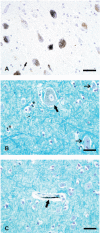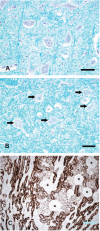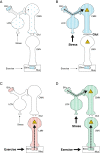Uptake of inorganic mercury by human locus ceruleus and corticomotor neurons: implications for amyotrophic lateral sclerosis
- PMID: 24252585
- PMCID: PMC3893560
- DOI: 10.1186/2051-5960-1-13
Uptake of inorganic mercury by human locus ceruleus and corticomotor neurons: implications for amyotrophic lateral sclerosis
Abstract
Background: Environmental toxins are suspected to play a role in the pathogenesis of amyotrophic lateral sclerosis (ALS). In an attempt to determine which pathways these toxins can use to enter motor neurons we compared the distribution of mercury in the CNS of a human and of mice that had been exposed to inorganic mercury.
Results: In the human who had been exposed to metallic mercury, mercury was seen predominantly in the locus ceruleus and corticomotor neurons, as well as in scattered glial cells. In mice that had been exposed to mercury vapor or mercuric chloride, mercury was present in lower motor neurons in the spinal cord and brain stem.
Conclusions: In humans, inorganic mercury can be taken up predominantly by corticomotor neurons, possibly when the locus ceruleus is upregulated by stress. This toxin uptake into corticomotor neurons is in accord with the hypothesis that ALS originates in these upper motor neurons. In mice, inorganic mercury is taken up predominantly by lower motor neurons. The routes toxins use to enter motor neurons depends on the nature of the toxin, the duration of exposure, and possibly the amount of stress (for upper motor neuron uptake) and exercise (for lower motor neuron uptake) at the time of toxin exposure.
Figures




Similar articles
-
Inorganic mercury in human astrocytes, oligodendrocytes, corticomotoneurons and the locus ceruleus: implications for multiple sclerosis, neurodegenerative disorders and gliomas.Biometals. 2018 Oct;31(5):807-819. doi: 10.1007/s10534-018-0124-4. Epub 2018 Jun 29. Biometals. 2018. PMID: 29959651 Free PMC article.
-
Heavy metals in locus ceruleus and motor neurons in motor neuron disease.Acta Neuropathol Commun. 2013 Dec 12;1:81. doi: 10.1186/2051-5960-1-81. Acta Neuropathol Commun. 2013. PMID: 24330485 Free PMC article.
-
Inorganic mercury is transported from muscular nerve terminals to spinal and brainstem motoneurons.Muscle Nerve. 1992 Oct;15(10):1089-94. doi: 10.1002/mus.880151006. Muscle Nerve. 1992. PMID: 1383815
-
Gender differences in the uptake of inorganic mercury by motor neurons.Neurotoxicol Teratol. 1997 Jul-Aug;19(4):287-93. doi: 10.1016/s0892-0362(97)00021-4. Neurotoxicol Teratol. 1997. PMID: 9253007
-
A novel hypothesis on metal dyshomeostasis and mitochondrial dysfunction in amyotrophic lateral sclerosis: Potential pathogenetic mechanism and therapeutic implications.Eur J Pharmacol. 2021 Feb 5;892:173737. doi: 10.1016/j.ejphar.2020.173737. Epub 2020 Nov 19. Eur J Pharmacol. 2021. PMID: 33220280 Review.
Cited by
-
Age-related accumulation of toxic metals in the human locus ceruleus.PLoS One. 2018 Sep 19;13(9):e0203627. doi: 10.1371/journal.pone.0203627. eCollection 2018. PLoS One. 2018. PMID: 30231068 Free PMC article.
-
Is psychological stress a predisposing factor for amyotrophic lateral sclerosis (ALS)? An online international case-control study of premorbid life events, occupational stress, resilience and anxiety.PLoS One. 2018 Sep 21;13(9):e0204424. doi: 10.1371/journal.pone.0204424. eCollection 2018. PLoS One. 2018. PMID: 30240431 Free PMC article.
-
Inorganic mercury in human astrocytes, oligodendrocytes, corticomotoneurons and the locus ceruleus: implications for multiple sclerosis, neurodegenerative disorders and gliomas.Biometals. 2018 Oct;31(5):807-819. doi: 10.1007/s10534-018-0124-4. Epub 2018 Jun 29. Biometals. 2018. PMID: 29959651 Free PMC article.
-
Elemental biomapping of human tissues suggests toxic metals such as mercury play a role in the pathogenesis of cancer.Front Oncol. 2024 Jun 21;14:1420451. doi: 10.3389/fonc.2024.1420451. eCollection 2024. Front Oncol. 2024. PMID: 38974240 Free PMC article.
-
Effect of alpha-mangostin in the prevention of behavioural and neurochemical defects in methylmercury-induced neurotoxicity in experimental rats.Toxicol Rep. 2022 Apr 22;9:977-998. doi: 10.1016/j.toxrep.2022.04.023. eCollection 2022. Toxicol Rep. 2022. PMID: 35783250 Free PMC article.
References
-
- Chio A, Calvo A, Mazzini L, Cantello R, Mora G, Moglia C, Corrado L, D’Alfonso S, Majounie E, Renton A, Pisano F, Ossola I, Brunetti M, Traynor BJ, Restagno G. Extensive genetics of ALS: a population-based study in italy. Neurology. 2012;1:1983–1989. doi: 10.1212/WNL.0b013e3182735d36. - DOI - PMC - PubMed
-
- Conte A, Lattante S, Luigetti M, Del Grande A, Romano A, Marcaccio A, Marangi G, Rossini PM, Neri G, Zollino M, Sabatelli M. Classification of familial amyotrophic lateral sclerosis by family history: effects on frequency of genes mutation. J Neurol Neurosurg Psychiatry. 2012;1:1201–1203. doi: 10.1136/jnnp-2012-302897. - DOI - PubMed
Publication types
MeSH terms
Substances
LinkOut - more resources
Full Text Sources
Other Literature Sources
Medical
Miscellaneous

